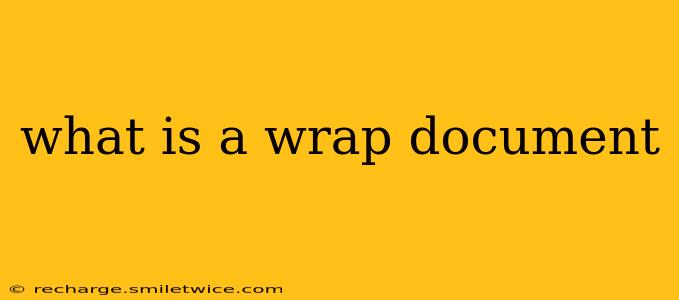A wrap document, also known as a project wrap-up report or post-project report, is a concise yet comprehensive summary of a completed project. It serves as a final record detailing the project's objectives, accomplishments, challenges encountered, and lessons learned. Think of it as the project's final narrative, offering valuable insights for future endeavors. More than just a list of tasks completed, a well-crafted wrap document provides a holistic view of the project's journey.
What information does a wrap document typically include?
A typical wrap document covers several key areas, offering a multifaceted perspective on the completed project. These usually include:
- Project Overview: A brief introduction restating the project's goals, timeline, and key stakeholders. This sets the stage for the rest of the document.
- Accomplishments and Deliverables: A detailed account of what was achieved. This section often includes specific metrics, milestones reached, and a clear demonstration of how the project met (or didn't meet) its objectives. Evidence of successful completion, such as reports, presentations, or software releases, might be referenced here.
- Challenges and Issues: An honest assessment of the hurdles faced during the project. This section shouldn't shy away from difficulties; rather, it should highlight how they were overcome or mitigated. Identifying problems and solutions provides valuable learning experiences.
- Lessons Learned: This is arguably the most critical part of a wrap document. It's where the team reflects on what worked well, what could be improved, and what changes could be implemented in future projects. This often includes suggestions for process improvements, tool upgrades, or team dynamics adjustments.
- Financial Summary (if applicable): For projects with a significant budget, a summary of the actual costs versus the planned budget is usually included. This may also include a breakdown of expenses.
- Team Contributions: Recognizing the contributions of team members fosters a sense of accomplishment and highlights individual strengths.
Why are wrap documents important?
The importance of wrap documents extends beyond simply archiving project details. They are valuable tools for:
- Knowledge Transfer: They preserve the knowledge gained during the project, ensuring that valuable information isn't lost when team members move on to other projects.
- Continuous Improvement: By analyzing what went well and what didn't, organizations can refine their processes and improve future project outcomes.
- Stakeholder Communication: They provide a clear and concise summary of the project's success (or areas for improvement) to all involved parties, including clients, management, and team members.
- Risk Management: By documenting challenges and solutions, organizations can better anticipate and address similar issues in the future.
- Historical Record: The wrap document serves as a valuable record for future reference, providing a complete overview of the project's lifecycle.
Who is responsible for creating a wrap document?
The responsibility for creating a wrap document often falls on the project manager or a designated team member. However, it’s crucial to involve the entire team in the process to ensure a comprehensive and accurate reflection of the project's experiences.
What format should a wrap document follow?
While there's no single prescribed format, a clear and logical structure is essential. Using headings, subheadings, bullet points, and visuals (charts, graphs) can enhance readability and make the information easily digestible. A concise and professional tone is also vital.
How long should a wrap document be?
The length of a wrap document varies depending on the project's scope and complexity. However, aiming for conciseness and clarity is always recommended. A well-structured document can convey substantial information within a few pages, while a poorly structured one can feel unnecessarily lengthy.
By carefully considering these elements, you can craft a wrap document that is both informative and valuable, serving as a legacy to the project's journey and a guide for future success.
